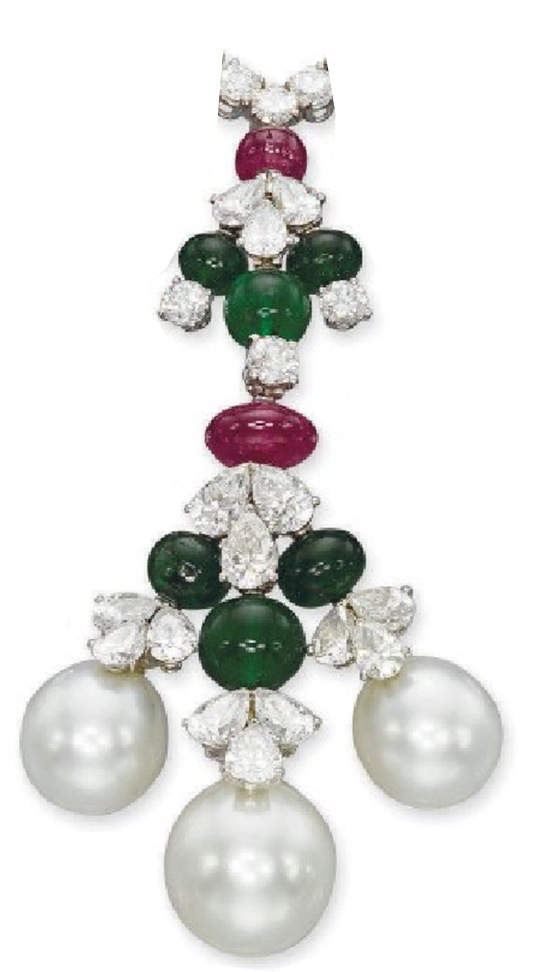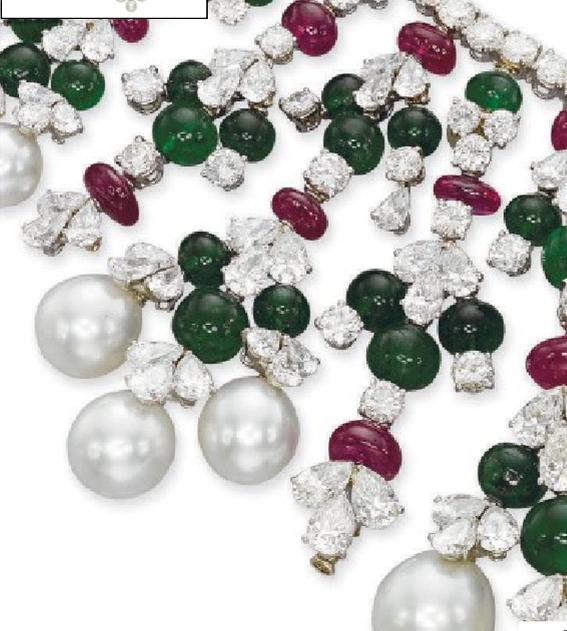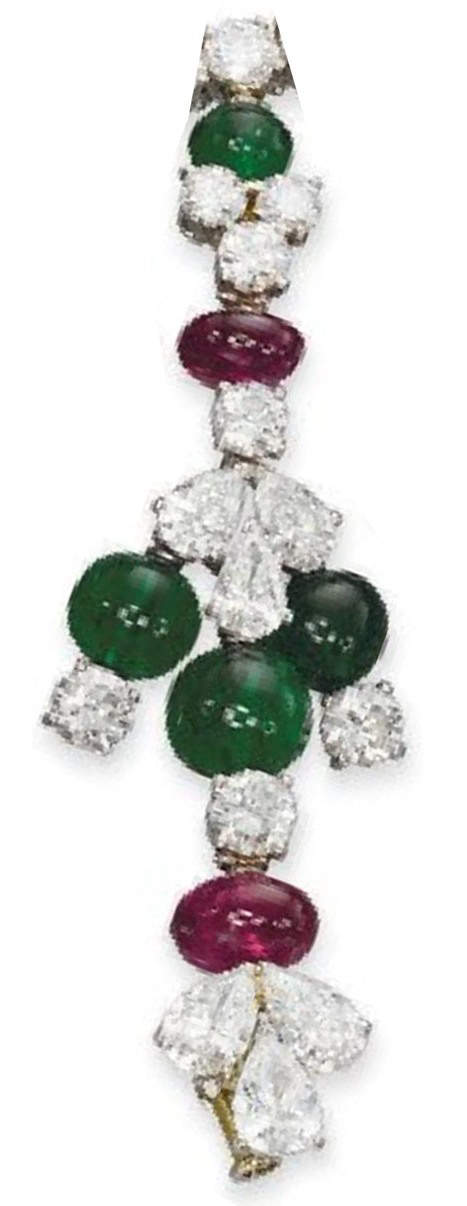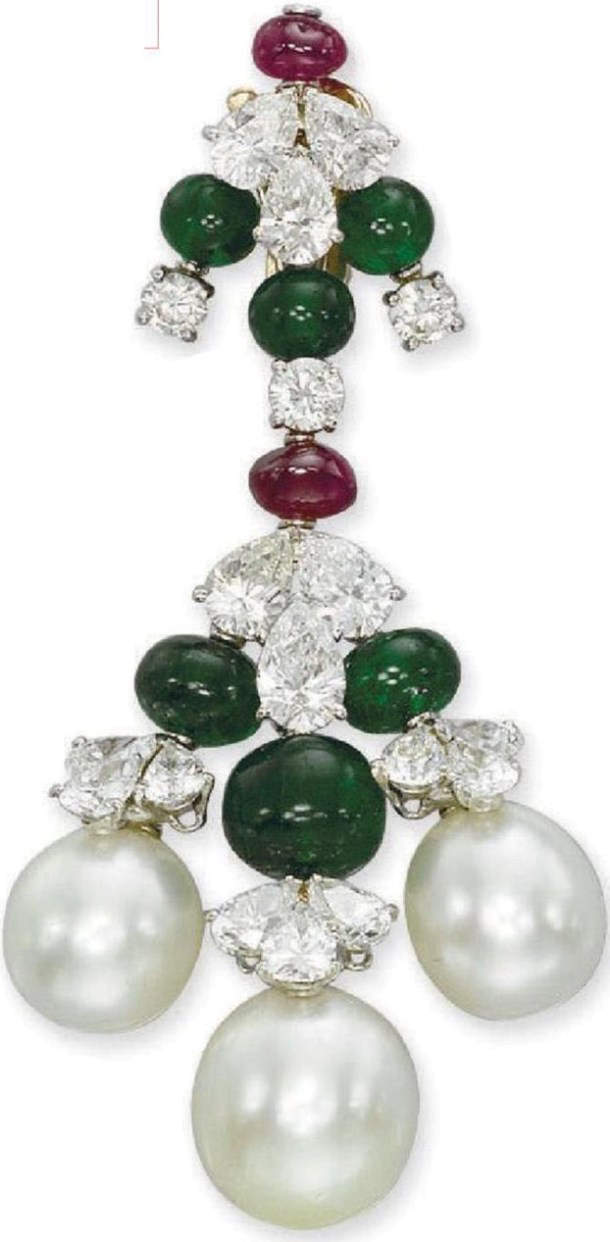Diamond, Emerald, Ruby and Cultured Pearl Fringe Necklace and Matching Pair of Earrings
Open FREE Unlimited Store Join Our Newsletter
Origin of Name
The name refers to a demi-parure made up of a necklace and matching pair of earrings, referred to as a "Multi-gem and Cultured Pearl Set of Jewelry" that appeared at the Christie's "Jewels : The Geneva Sale" held on May 12, 2010, at the Geneva - Four Seasons Hotel des Bergues. The term "multi-gem" refers to three of the most valuable precious stones, diamonds, emeralds and rubies. The predominant gemstone in the jewelry suite is diamonds, followed by emeralds, rubies and cultured pearls. The necklace, which is the main piece of jewelry in the suite, is a fringe necklace, the fringes arising from a line of brilliant-cut diamonds set end to end. The emeralds, rubies and pearls are situated on the fringes, and so are the diamond spacers that separate them. The matching pair of earrings are designed on the same basic plan as the fringes, incorporating the same type of gemstones and pearls. The lot that was given a moderate presale estimate of CHF 50,000-70,000 (US$ 45,122 - 63,171), made a significant impact at the auctions, when it finally clinched a hammer price of CHF 183,000 (US$ 165,176) which was more than double the upper pre-sale estimate.
Characteristics of the Multi-gem and Cultured Pearl Demi-Parure
1) Diamond, Emerald, Ruby and Cultured Pearl Fringe Necklace
Design features of the fringe necklace
The necklace is a "choker" under the modern system of classifying necklaces
The necklace is 38 cm long, equivalent to 15 inches. Under the modern system of classifying necklaces based on their lengths, a length of 15 inches, falls within the category of a choker, whose range in length varies from 14 to 16 inches.

Diamond, Emerald, Ruby and Cultured Pearl Fringe Necklace
© Christie's
Design of the main-strand of the necklace
The main strand of the necklace is made of yellow gold, consisting of flexible square-shaped links, in which round brilliant-cut diamonds are claw-set (prong-set) and placed end to end. In the section of the necklace that is visible on the photograph, the main strand has 65 brilliant-cut diamonds placed end to end. The fringes of the necklace arise from the yellow-gold framework of the main strand of the necklace, and are made of either gold or platinum. French assay marks for platinum and gold are seen on the necklace.

Part of the main strand of the fringe necklace
© Christie's
The fringes of the necklace
There are 21 fringes on the necklace, a large, central and median fringe, and 10 smaller fringes on either side. The length of the fringes gradually decrease towards the rear side of the necklace. There are two types of fringes on the necklace, 1) fringes ending with cultured pearl terminals 2) fringes without cultured pearls, and terminating with a triad of pear-shaped diamonds. Fringes of the corresponding type and length are place equidistant from the median fringe. The two types of fringes are placed alternating with one another. The two fringes can also be easily identified by the gemstone situated at the point of origin of the fringe. While fringes carrying cultured pearl terminals originate in oval-shaped or button-shaped red-ruby beads, those ending in triads of pear-shaped diamonds, originate in a triad of round brilliant-cut diamonds, except for the two fringes situated on either side of the central fringe, that arise in a near-spherical or button-shaped emerald bead. The 3rd and 4th pearl-carrying fringes from the central fringe, terminate only in single pearls, whereas the other pearl-carrying fringes terminate in three pearls.
Design of the main fringe
The main fringe is of the first type terminating in three cultured pearls and originating in a spherical red-ruby bead. Just below this ruby-bead is a gold or platinum setting, prong-set with a triad of pear-cut diamonds. From the framework of each of these pear-cut diamonds, arise a large emerald bead, out of which the largest is the spherical central emerald bead, and the two emeralds on either side of it are smaller and button-shaped. The two smaller emerald beads end abruptly in a round brilliant-cut diamond, mounted in a square-shaped prong-setting. However, the fringe is continued further through the central, large, spherical, emerald bead. Immediately below the central, large, spherical, emerald bead is a round brilliant-cut diamond, mounted in a square-shaped prong-setting, which is followed by an oval or button-shaped ruby bead. The ruby bead is followed by the same sequence of gemstones as at the beginning of the fringe, with a triad of pear-cut diamonds, followed by three emerald beads, out of which the central emerald bead is the largest and almost spherical, and the two emerald beads on either side of it are smaller and button-shaped. Each of the three emeralds are now followed by a triad of pear-cut diamonds, each terminating in a large, spherical, silvery-white, cultured pearl, fixed to the framework of the central pear-cut diamond of the triad.

The Main Fringe of the Necklace
© Christie's
Thus, in the main fringe of the necklace, which is the largest of all the fringes, there are 2 rubies, 6 emeralds, 15 pear-cut diamonds, 3 brilliant-cut diamonds and 3 cultured pearls, making a total of 29 gemstones.
Design of a side fringe ending with three cultured pearls
The fringe originates with a button-shaped ruby bead, followed by a triad of pear-cut diamonds. Each of the pear-cut diamonds is followed by a large emerald-bead, the largest spherical bead in the center and two smaller button-shaped beads on the two sides. The smaller emerald bead towards the median fringe, end with a round brilliant-cut diamond followed by a pear-cut diamond; but the other small emerald bead end abruptly only in a single brilliant-cut diamond. The fringe continues downwards through the central large spherical emerald, the first gemstone immediately after the emerald being a round brilliant-cut diamond. The sequence of the gemstones are then repeated, starting with a button-shaped ruby bead followed by a triad of pear-cut diamonds. Each of the three pear-cut diamonds is followed by a button-shaped emerald bead, the central emerald bead being larger than the emerald-bead on the sides. Each of the emerald beads is followed by a triad of pear-cut diamonds, terminating in a single large spherical or near-spherical pearl. arising from just below the central pear-cut diamond.

A Side Fringe Terminating in Three Cultured Pearls
© Christie's
The number of each variety of gemstones on a side fringe are, 2 rubies, 6 emeralds, 16 pear-cut diamonds, 3 brilliant-cut diamonds and 3 cultured pearls, making a total of 30 gemstones. Thus, the number of different types of gemstones is the same as in the main fringe, except for an additional pear-cut diamond.
Design of a side fringe terminating with a triad of pear-cut diamonds
These side fringes alternating with the fringes carrying three cultured pearls, originate usually in a triad of brilliant-cut diamonds, except for the two fringes on either side of the main fringe, that originate in a button-shaped emerald bead, but is soon followed by a triad of brilliant-cut diamonds. The triad of brilliant-cut diamonds is followed by a button-shaped ruby bead, which is then followed by a single brilliant-cut diamond, and then a triad of three pear-cut diamonds, each of which is followed by a large near-spherical emerald bead, of which the central emerald is the largest and the two emerald beads on the sides slightly smaller. The two emerald beads on the sides end abruptly in a round brilliant-cut diamond, mounted on a square prong-setting. The fringe is continued through the central large emerald bead, which is followed by a single round brilliant-cut diamond, and then a button-shaped ruby, that ends in a triad of pear-shaped diamonds. There are no pearls in these fringes.

Side Fringe Terminating in a Triad of Pear-Cut Diamonds
© Christie's
The number of pieces of each variety of gemstones in these fringes are, 3 or 4 emeralds, 2 rubies, 7 brilliant-cut diamonds and 6 pear-cut diamonds, making a total of 18 or 19 gemstones.
Computation of the different types of gemstones in the fringes of the necklace
The number of emeralds, rubies, brilliant-cut diamonds, pear-cut diamonds and cultured pearls in the main fringe, and the 10 fringes on one side of the necklace is tabulated in the following table. Using this data, the total number of each type of gemstone used in the 10 fringes on one side of the main fringe has been computed, and then by multiplying these figures by 2, we have arrived at the total number of each type of gemstone used in the 10 fringes on both sides, as well as the main fringe. The final computation shows that the total number of emeralds used in the fringes are 72, rubies 32, brilliant-cut diamonds 87, pear-cut diamonds 155 and cultured pearls 19, giving a total of 365 gemstones of all varieties in the fringes. If the 65 brilliant-cut diamonds on the main strand of the necklace is also added to this, the total number of different types of gemstones in the entire necklace becomes approximately 430.
| S/N | Name of Fringe | Number of Emeralds | Number of Rubies | Number of brilliant-cut diamonds | Number of pear-cut diamonds | Number of Cultured Pearls | Total Number of Gemstones on one-half of the fringes | Total Number of Gemstones in the fringes on both sides |
| 1 | Main Fringe | 6 | 2 | 3 | 15 | 3 | 29 | 29 |
| 2 | First Fringe | 4 | 2 | 7 | 6 | 0 | 19 x 2 | 38 |
| 3 | Second Fringe | 6 | 2 | 3 | 16 | 3 | 30 x 2 | 60 |
| 4 | Third Fringe | 3 | 2 | 7 | 6 | 0 | 18 x 2 | 36 |
| 5 | Fourth Fringe | 6 | 2 | 3 | 15 | 3 | 29 x 2 | 58 |
| 6 | Fifth Fringe | 3 | 1 | 6 | 6 | 0 | 16 x 2 | 32 |
| 7 | Sixth Fringe | 3 | 2 | 3 | 6 | 1 | 15 x 2 | 30 |
| 8 | Seventh Fringe | 3 | 1 | 6 | 6 | 0 | 16 x 2 | 32 |
| 9 | Eighth Fringe | 3 | 1 | 2 | 3 | 1 | 10 x 2 | 20 |
| 10 | Ninth Fringe | 2 | 1 | 5 | 3 | 0 | 11 x 2 | 22 |
| 11 | Tenth Fringe | 0 | 1 | 0 | 3 | 0 | 4 x 2 | 8 |
| 12 | Total (without main fringe, on one-half of necklace | 33 x 2 | 15 x 2 | 42 x 2 | 70 x 2 | 8 x 2 | 168 x 2 | 336 |
| 13 | Total (without the main fringe, on both sides of the necklace) | 66 | 30 | 84 | 140 | 16 | 336 | 336 |
| 14 | Total (with the main fringe) | 72 | 32 | 87 | 155 | 19 | 365 | 365 |
Design of the Ear Pendants
The design of the ear pendants are based on the fringes ending with three cultured pearl terminals, and originating with a button-shaped red-ruby. They are similar in design and composition to the main fringe of the necklace or the fourth fringe from the main fringe, listed in the 5th row of the above table.

Ear Pendants Similar in Design to the Main Fringe
© Christie's
The ear pendants, that are 7.5 cm long, originate with a button-shaped red ruby bead, followed by triad of pear-cut diamonds. Each of the pear-cut diamonds is followed by a large almost spherical emerald. The two emeralds on either side end abruptly in a brilliant-cut diamond. The fringe is continued through the central spherical emerald bead, that is followed by a single brilliant-cut diamond, and then beginning with a second button-shaped red ruby, the sequence is repeated. A second triad of pear-cut diamonds is situated immediately after the second ruby. Each of these pear-cut diamonds is followed by a large emerald, out of which the central emerald is the largest and almost spherical, and the two emeralds on the sides are smaller and button-shaped. Each of the emeralds are followed by a triad of pear-cut diamonds, that finally terminate in a single, large, silvery-white, spherical, cultured pearl. Thus, each ear pendant has 6 emeralds, 2 rubies, 3 brilliant-cut diamonds, 15 pear-cut diamonds and 3 pearls, making a total of 29 gemstones.
History of the Multi-gem and Cultured Pearl Demi-Parure
The Period of origin of the diamond, colored stone and cultured pearl fringe necklace
The diamond, colored stone and cultured pearl fringe necklace most probably originated after 1954, the year of founding of the designing company Atelier Georland
The design of the Diamond, Emerald, Ruby and Cultured Pearl Fringe Necklace is a masterpiece in jewelry creation, combining creative art and mathematical precision, with a perfect synthesis of cultured pearls and white diamonds with colored stones. The necklace is perfectly symmetrical about a median line occupied by the main fringe, with fringes similar in design, composition and length occupying corresponding positions on the necklace. The maker's mark on the necklace reveals the identity of the designers of this exquisitely crafted necklace, and it is none other than the renowned jewelry designers of France, Atelier Georland, based in Paris with a branch office in New York's Fifth Avenue. The company was founded in 1954 by Henry Marteau, the son of a French Army General. The year of manufacture of this piece is not known, but undoubtedly it originated after 1954, the year of the company's founding.
If the 19 cultured pearls are South Sea pearls, the necklace most probably originated only after the late 1970s, when such pearls first entered the international pearl markets
The 19 cultured pearls used in the necklace, which looks like cultured South Sea pearls, may provide a further indication of the period of origin of the necklace. The mother-of-pearl industry of Australia, based on the oyster species, Pinctada maxima, collapsed in the mid-1950s, after the manufacture of cheap plastic buttons, that spelt the doom of the industry. Natural South Sea pearls that entered the international pearl markets prior to the collapse, was a by-product of the mother-of-pearl industry. Nicholas Paspaley Sr. set up the first experimental cultured pearl farm in Australia, based on the South Sea pearl oyster Pinctada maxima, in 1956 in Kuri Bay, 420 km north of Broome, in collaboration with a Japanese pearl culturist Kuribavashi. However, the results were not encouraging due to high mortality rates. In 1963, the Paspaley Pearling Company started a second cultured pearl farm at Port Essington, East of Darwin, in collaboration with another Japanese Company, the Arafura Pearling Company. This project too ended up in failure due to the same reasons. After intensive research undertaken by Nicholas Paspaley and his son Nicholas Paspaley Jr. and a team of scientists and technicians, the Japanese culturing techniques applied for the Akoya pearl oyster, were successfully modified to suite the sensitive Pinctada maxima oysters, resulting in the successful culturing of South Sea pearls in the mid-1970s, that reduced mortality rates, and produced bigger and more luxurious pearls. Thus, the first cultured South Sea pearls entered the international pearl markets only in the late-1970s. Thus, if the 19 pearls used in the fringe necklace are indeed cultured South Sea pearls, the necklace must have been designed only after the late 1970s.
Sources of the gemstones used in the fringe necklace and pair of ear-pendants
Atelier Georland has a tradition of acquiring its precious stones, such as diamonds, rubies, emeralds and sapphires, from the original sources of these gemstones from around the world. They always select the best stones that come from these mines around the world, and engage the best lapidaries in the world to cut and polish these gemstones, to suite their requirements.
The rubies in the necklace most probably originated in the Mogok stone tract in the Mogok Valley in Burma (Myanmar), the premier source of the finest rubies in the world.
The emeralds in the necklace most probably originated in one of the three main emerald mining areas in Colombia, Muzo, Coscuez and Chivor or the new deposit discovered in the town of Maripi, close to Borbur and Muzo.
The source of the white diamonds, the main component of the necklace, may be one of the many mines currently operating in South Africa, Botswana, and Angola or the few mines operating in Lesotho, Zimbabwe or Tanzania.
The source of the silvery-white, cultured pearls, with a luster and brilliance of saltwater pearls, may be either Japan or Australia. If the pearls are cultured Akoya pearls, the most probable source is Japan, but if the pearls are cultured South Sea pearls, the most probable source is Australia. According to the size, color, overtone, luster, orient and surface-quality of the pearls, they appear to be South Sea cultured pearls, whose range in size varies from 9 mm to 20 mm. Akoya cultured pearls have a range in size of 5 mm to 8 mm.
Atelier Georland, high-end jewelry designers and manufacturers
The founding of the company and their New York branch
Atelier Georland, the renowned jewelry designers of France, was founded in 1954 in Paris, by Henry Marteau, the son of a French Army General. Following the success of this venture, in 1958, just four years after the founding of the company, Henry Marteau went international, by opening their first branch in 5th Avenue, New York. Since the early 1960s the company had undertaken the craftsmanship of jewelry for most of the prestigious French and International Jewelers. The company had also designed and created its own jewelry collections, that was distributed by selected independent jewelers and luxury chain retailers.
Reorganization of the company by Stephane Marteau and Jean-Gabriel Marteau after the death of their father in 1993
Henry Marteau died in 1993, and was succeeded by his two sons Stephane and Jean-Gabriel, who reorganized the operations of the company, setting up new methods for planning and monitoring production, a new Development Center installed with state-of-the-art equipment, and expanding production capacity, and exploring new precious stone sources. The successful re-organization resulted in a phenomenal increase in the income of the company and an expansion of its clientele.
A third generation of Marteaus assist in the running and development of the company
Today, a third generation of Marteaus, Romain (26), Axel (24), Jean-Jerome (23) and Clement (21), the grandsons of Henry Marteau, have been co-opted to serve the company, and are working alongside their fathers to take the company to greater heights. Romain Marteau, who has obtained a degree in International Business, has now reopened the New York operation of the company, which was shut down after founder Henry's death in 1993.
Special training given to handpicked members of Staff of the company, at prestigious Parisian Jewelry Schools
New technical innovations, such as Computer-Aided Design (CAD) technology, is employed by the Development Center, in creating new designs for jewelry collections, hitherto unseen in any jewelry collection. Georland has a working partnership with most of the Parisian Jewelry Schools, in which the company trains its handpicked staff, who follow a two-year training program in skills such as Computer-Aided Design (CAD), metal casting, metal crafting, preciousstone sorting, stone setting, micro-setting, enameling and polishing. After training each staff member specializes in of the skills above, depending on his individual ability. A member of the technical staff is promoted as a team or project manager only after a minimum of 15 years experience.
You are welcome to discuss this post/related topics with Dr Shihaan and other experts from around the world in our FORUMS (forums.internetstones.com)
Related :-
1) Italian Noble Family Collection - Natural Pearl and Diamond Necklace
2) Umm Kulthum's Nine-Stranded Pearl Necklace
External Links
1) Christie's "Jewels : The Geneva Sale" 1374, May 12, 2010. Lot No.151 - A Multi-Gem and Cultured Pearl Set of Jewelry by Atelier Georland
2) Georland - Histoire - www.georland.com
References :-
1) Christie's "Jewels : The Geneva Sale" 1374, May 12, 2010. Lot No.151 - A Multi-Gem and Cultured Pearl Set of Jewelry by Atelier Georland.
2) List of Diamond Mines - From Wikipedia, the free encyclopedia
3) Guinness Emerald Crystal - www.internetstones.com
4) Paspaley Drop-shaped Pearls - www.internetstones.com
5) Marilyn Monroe Pearl Necklace - www.internetstones.com
6) Georland - Histoire - www.georland.com
Powered by Ultra Secure
Amazon (USA) Cloud Network

Founder Internet Stones.COM
Register in our Forums
| Featured In
|
|
|
|
|
|
|
|


















